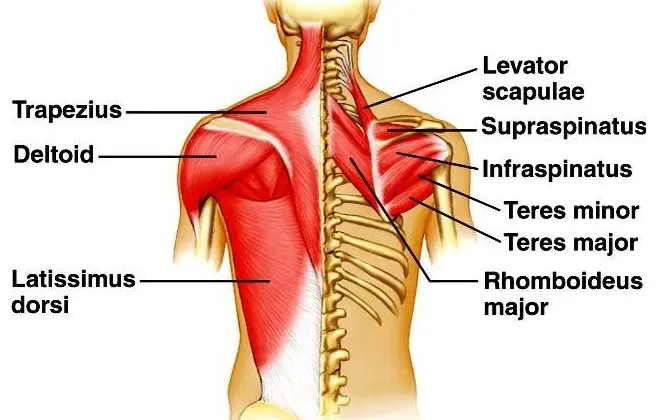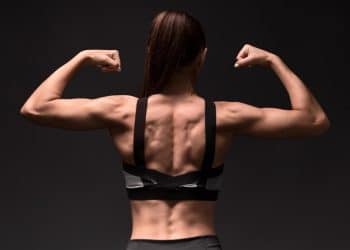A thick, broad upper back is the cornerstone of a powerful physique and contributes to a V-taper. Back training is also crucial for long-term shoulder health and good posture. Skipping back day is a terrible idea and will wreak havoc on your aesthetics and gym performance.
Just because your back is out of sight, it should never be out of mind. As a veteran personal trainer with over 35 years in the trenches, I see many people leave gains on the table by choosing ineffective exercises.
While isolation exercises have their place in a back workout, limiting yourself to these lifts can hinder your gains. Some lifters also favor isolation lifts because they are inherently easier than multi-joint exercises. However, if you aim to build muscle mass and size, you must prioritize compound movements.
In this article, I share the 15 most effective compound back exercises and workouts to beef up your back in the shortest time possible.
Recent Updates: On May 30, 2024, Fitness Volt’s Senior Editor, Vidur Saini (American Council on Exercise-CPT), updated the article with actionable expert tips to improve the reader experience. Level Up Your Fitness: Join our 💪 strong community in Fitness Volt Newsletter. Get daily inspiration, expert-backed workouts, nutrition tips, the latest in strength sports, and the support you need to reach your goals. Subscribe for free!
14 Best Compound Back Exercises
Add the following exercises to your training arsenal:
- Conventional deadlift
- Pull-up/chin-up
- Lat pulldown
- Bent-over barbell row
- Yates row
- Pendlay row
- T-bar row
- Seal row
- Single-arm dumbbell row
- Kroc row
- Meadows row
- Seated cable row
- Horizontal row
- Face pull
1. Conventional deadlift
| Sets & Reps | 3-5 sets of 1-5 reps (strength) OR 3-4 sets of 6-8 reps (hypertrophy) |
| Equipment Needed | Barbell, weight plates (optional: lifting belt, chalk) |
| Target Muscles | Lats, trapezius, rhomboids, posterior deltoids, erector spinae, gluteus maximus, hamstrings, quadriceps, forearms, biceps, core |
Although the deadlift is a full-body exercise, it biases the posterior chain. As you deadlift, you must use your entire back to keep your spine straight and your shoulders down and back.
“Focus on wedging yourself under the bar before initiating the pull,” said Saini. For better stability, engage your lats before you lift to pull the slack out of the bar.
Steps:
- Load a barbell with an appropriate weight.
- Stand behind the bar with your toes under it. Your feet should be hip-width apart.
- Lean forward and grab the bar with an overhand or mixed shoulder-width grip. Straighten your arms, drop your hips, lift your chest, and pull your shoulders down and back. Brace your abs.
- Drive your feet into the floor and stand up. Do not allow your hips to shoot up or your lower back to round.
- Stand up straight but do not lean backward, as doing so increases your risk of injury.
- Push your hips back, bend your knees, and lower the bar back down your legs to the floor.
- Let the weight settle, reset your core and grip, and repeat.
Coach Tips:
- Use lifting straps or gym chalk to reinforce your grip.
- If you use a mixed grip, make sure you switch your hands to avoid developing muscle imbalances.
- Increase upper back engagement by using a wider grip, i.e., snatch grip deadlifts, like this:
| Difficulty | Progression | Regression |
| Intermediate | Deficit deadlift, Romanian deadlift, block pulls | Trap bar deadlift, kettlebell deadlift |
Related: 10 Ways to Boost Your Deadlift
2. Pull-up/chin-up
| Sets & Reps | 3-4 sets to near failure |
| Equipment Needed | Pull-up bar |
| Target Muscles | Lats, biceps, forearms, rear deltoids, lower traps, rhomboids |
Pull-ups use an overhand or pronated grip, while chin-ups use an underhand or supinated grip. Very few exercises will add width to your back, like pull-ups and chin-ups.
Saini suggests retracting and depressing the scapula at the top of your range of motion (ROM) to maximize lat engagement and minimize biceps reliance on the lowering phase.
Steps:
- Hang from an overhead bar with a slightly wider than shoulder-width overhand grip (pull-ups) or a slightly narrower than shoulder-width underhand grip (chin-ups).
- Your arms should be straight, feet off the floor, and shoulders pulled back and down.
- Without swinging or kicking, flex your elbows and pull your chin up and over the bar. Drive your elbows down and back to maximize back engagement.
- Descend smoothly and under control, and then repeat.
Coach Tips:
- Wear a weighted vest, use a pull-up/dip belt, or hold a dumbbell between your ankles to make this exercise more challenging.
- Use a resistance band for assistance if you cannot perform pull-ups or chin-ups.
- Use a narrow, neutral grip and pull your sternum up to the bar to emphasize your mid-back, like this:
| Difficulty | Progression | Regression |
| Intermediate | Assisted pull-ups (machine/bands), negatives | Isometric holds, Australian pull-ups |
3. Lat pulldown
| Sets & Reps | 3-4 sets of 8-12 reps (hypertrophy) or 3-5 sets of 5-8 reps (strength) |
| Equipment Needed | Lat pulldown machine, various attachments (wide, close, neutral grip) |
| Target Muscles | Lats (emphasis varies with grip width), biceps, rear deltoids, traps |
Lat pulldowns are an excellent option for anyone unable to do pull-ups. You can adjust the weight to suit your abilities. As an added advantage, you can use many different grips and hand positions to hit your back from a range of angles.
For example, you can use a wide, medium, or narrow overhand grip, a medium or narrow parallel grip, or a medium or narrow underhand grip. However, despite these variations, the lat pulldown will always be mainly a lat exercise. So, try all the grip options to see which you prefer and what works best for you.
For example, you can use a wide, medium, or narrow overhand grip, a medium or narrow parallel grip, or a medium or narrow underhand grip. However, despite these variations, the lat pulldown will always be mainly a lat exercise. So, try all the grip options to see which you prefer and what works best for you.
Steps:
- Attach your chosen handle to the overhead pulley. Grip it and sit down on the machine, so your thighs are under the pads.
- Lean back slightly and lift your chest up. Pull your shoulders down and back, and brace your core.
- Without using your lower back for help, bend your arms and pull the handle down to your upper chest. Lead with your elbows, and keep your wrists straight.
- Extend your arms and repeat, taking care not to relax your shoulders between reps.
Coach Tips:
- Think about touching your hips with your elbows to maximize back muscle engagement.
- It’s okay to arch your back when doing lat pulldowns.
- Only lean back enough so you don’t hit your head when you pull the bar down. Leaning back further will turn what should be a vertical pull into a horizontal pull.
| Difficulty | Progression | Regression |
| Beginner | Close grip lat pulldown, V-bar pulldown | Band pulldowns |
4. Bent-over barbell row
| Sets & Reps | 3-4 sets of 6-8 reps (strength) OR 3-4 sets of 8-12 reps (hypertrophy) |
| Equipment Needed | Barbell, weight plates |
| Target Muscles | Lats, rhomboids, traps, rear deltoids, biceps, erector spinae |
Bodybuilders have a saying — if you want to grow, you’ve got to row. Rows make your upper back thicker and stronger, and there are plenty of options to choose from. That said, the original rowing exercise is the bent-over barbell row. This old-school classic is guaranteed to add slabs of muscle to your upper and lower back.
Instead of pulling the bar to your chest, focus on driving your elbows towards your hips for a greater lat engagement, recommends Saini.
Steps:
- Hold your barbell with an overhand shoulder-width grip. Brace your core and pull your shoulders down and back.
- Bend your knees slightly and lean forward from the hips until your upper body is just above parallel to the floor. Let your arms hang down from your shoulders.
- Bend your elbows and pull the bar into your abdomen. Lead with your elbows, and keep your wrists straight.
- Extend your arms and repeat, taking care not to relax your core between reps.
Coach Tips:
- Your lower back should be slightly arched and never rounded during this exercise.
- Rest your forehead against the back of an inclined bench for support if required.
| Difficulty | Progression | Regression |
| Beginner | Pendlay row, Yates row | Dumbbell rows, inverted rows |
5. Yates row
| Sets & Reps | 3-4 sets of 6-10 reps |
| Equipment Needed | Barbell, weight plates |
| Target Muscles | Lats, traps (especially mid and lower), rhomboids, rear deltoids, erector spinae, forearms, biceps, core |
The Yates row is named after six-time Mr. Olympia winner Dorian Yates. In this version of bent-over rows, you don’t lean over as far, making it considerably lower back-friendly than conventional bent-over rows. This was Yates’ favorite back exercise and helped him build one of the best backs in bodybuilding history.
“Keep your elbows tight to your sides and maintain a slight arch in your lower back throughout the movement,” says Saini. It will optimally load the lats and limit lower back strain.
Steps:
- Hold your barbell with an underhand, slightly less than shoulder-width grip.
- Stand with your feet about shoulder-width apart. Bend your knees slightly, brace your core, and pull your shoulders down and back.
- Hinging from the hips, lean forward until the barbell is just above knee height.
- Without using your legs or lower back, bend your arms and pull the barbell up to your abdomen.
- Extend your arms and repeat.
Coach Tips:
- You can also do the Yates row with dumbbells.
- Try doing Yates rows with an overhand instead of the more usual underhand grip.
- Expect to lift more weight than you would for conventional bent-over rows.
| Difficulty | Progression | Regression |
| Beginner | Bent-over row | Landmine row |
6. Pendlay row
| Sets & Reps | 3-4 sets of 5-8 reps |
| Equipment Needed | Barbell, weight plates |
| Target Muscles | Lats, traps, rhomboids, posterior deltoids, erector spinae, forearms, biceps, core |
Named after renowned coach Glen Pendlay, the Pendlay row (or dead-stop row) is unique for starting each rep with the weight on the floor. This demands extra effort to initiate the lift but allows a brief rest between reps for heavy lifting.
Saini urges beginners to start with 50 percent of their bent-over row weights in this exercise. Prioritize drilling the movement mechanics before moving to heavier weights.
Steps:
- Place your barbell on the floor and stand behind it with your toes under the bar and feet hip-width apart.
- Lean forward and grab the bar with an overhand, shoulder-width grip.
- Pull your shoulders down and back, brace your abs, and make sure your lower back is slightly arched and not rounded.
- Keeping your torso stationary, bend your arms and pull the barbell up to your midsection. Drive your elbows back and keep your wrists straight.
- Lower the bar back to the floor, allow it to rest there for a second and then repeat.
Coach Tips:
- Wear a weightlifting belt to support and protect your lower back.
- You can also do Pendlay rows with dumbbells, like this:
| Difficulty | Progression | Regression |
| Beginner | Bent-over row | Single-arm dumbbell row |
7. T-bar row
| Sets & Reps | 3-4 sets of 6-10 reps |
| Equipment Needed | T-bar row machine OR barbell with T-bar row attachment |
| Target Muscles | Lats, traps, rhomboids, rear deltoids, biceps |
T-bar rows are a classic bodybuilding back exercise. The bar pivots on a hinge, which provides a unique line of pull. Not only does this exercise stimulate your back from an unusual direction, but it’s also a little more lower-back friendly than regular bent-over barbell rows.
Saini recommends going as low as your mobility allows on the eccentric phase to achieve a deep lat stretch.
Steps:
- Step onto the T-bar row platform and stand with one foot on either side of the bar. Your feet should be shoulder to hip-width apart.
- Bend your knees slightly and hinge forward from your hips. Keep your back slightly arched. Brace your core.
- Grasp the handles with both hands. With your arms straight, lift the weight up until your torso is between 45 degrees and parallel to the floor.
- Bend your arms and pull the handle into your chest. Lead with your elbows, and keep your wrists straight. Do not allow your lower back to round.
- Lower the weight and repeat.
Coach Tips:
- Most T-bar row machines have wide, medium, narrow, and neutral grips. Try them all to see which you prefer.
- Experiment with the angle of your torso to see which you feel most in your lats and least in your lower back.
- If you do decide to do some cheat reps, make sure you use your legs for assistance and avoid rounding your lower back, as this can lead to injuries.
| Difficulty | Progression | Regression |
| Beginner | Bent-over row | Single-arm dumbbell row |
8. Seal row
| Sets & Reps | 3-4 sets of 8-12 reps |
| Equipment Needed | Bench, barbell, weight plates |
| Target Muscles | Lats, trapezius, rhomboids, posterior deltoids, forearms, biceps, core |
Most rowing back exercises involve a lot of lower back activity. While this is not necessarily a bad thing, it could limit the amount of weight you can lift. Also, for people suffering from back pain, it could make things worse. The seal row removes your lower back from the movement, leaving you free to focus on your lats and upper back.
“Maximize lower lat activation by pulling the bar toward your lower abs rather than your chest,” Saini says.
Steps:
- Place a flat bench on blocks or stacks of bumper plates, so your hands are a few inches away from the floor when you lie down.
- Lie face down on the bench, grip your barbell, and pull your shoulders down and back.
- Bend your arms and pull the bar up and into the bench level with your abdomen.
- Extend your arms, lower the weight, and repeat.
Coach Tips:
- Try dumbbell seal rows for variation and a greater range of motion.
- Lead with your elbows and keep your wrists straight to maximize muscle engagement.
| Difficulty | Progression | Regression |
| Beginner | Bent-over row | Single-arm dumbbell row |
9. Single-arm dumbbell row
| Sets & Reps | 3-4 sets of 8-12 reps per arm |
| Equipment Needed | Dumbbell, bench |
| Target Muscles | Lats, traps, rhomboids, rear deltoids, biceps |
Single-arm dumbbell rows allow you to train one side of your back at a time while using your free arm for support. Plus, using one dumbbell is a great way to identify and fix any left-to-right strength or muscle size imbalances. This classic back exercise definitely deserves a place in your workouts.
Saini suggests rotating your torso slightly as you row to maximize lat engagement.
Steps:
- Hold a dumbbell in your right hand and place your left hand and left knee on a flat exercise bench. Your torso should be parallel to the floor, with your hand directly beneath your shoulder and your knee beneath your hip.
- Let your arm hang down from your shoulder, brace your core, and pull your shoulder down and back.
- Bend your arm and pull the dumbbell up and into your lower ribs. Lead with your elbow and keep your wrist straight.
- Extend your arm and continue for the desired number of repetitions.
- Swap arms and repeat on the opposite side.
Coach Tips:
- Keep your upper arm close to your side to maximize lat engagement.
- You can also do this exercise with both feet on the floor, which some people find more balanced and comfortable.
| Difficulty | Progression | Regression |
| Beginner | Inverted row | Bent-over dumbbell row with both arms |
10. Kroc row
| Sets & Reps | 3-4 sets of 8-15 reps per arm (high volume for hypertrophy) |
| Equipment Needed | Dumbbell |
| Target Muscles | Lats, traps, rhomboids, biceps |
Some exercisers think Kroc rows are just single-arm rows done sloppily and with heavy weights. Not true! Kroc rows are a legitimate exercise that allows you to lift heavy weights for high reps. This exercise is popular with powerlifters who are certified experts in building a bigger, stronger back.
A bit of controlled momentum is your friend in this exercise, says Saini. It allows you to lift heavier and boost your training volume.
Steps:
- Hold a heavy dumbbell in one hand and stand with your feet about shoulder-width apart.
- Lean forward and place your supporting hand on a bench, dumbbell rack, or similar. Your shoulders should be above your hips, so your upper body is about 15 degrees to the floor.
- Brace your core and pull your shoulders down and back.
- Initiating the movement with your legs and hips, pull the dumbbell up and into the side of your abdomen. Then, shrug your shoulder back to maximally engage your upper back.
- Lower the weight, allowing your shoulder to flex forward at the bottom of each rep. Do not round your lower back.
- Explode up again and repeat, trying not to pause between reps.
Coach Tips:
- Use lifting straps, so your grip doesn’t fail before your back.
- You can also do Kroc rows with your knee and non-working hand resting on a bench.
| Difficulty | Progression | Regression |
| Beginner | Single-arm dumbbell row | Bent-over dumbbell rows with both arms |
11. Meadows row
| Sets & Reps | 3-4 sets of 8-12 reps per arm |
| Equipment Needed | Landmine attachment, barbell, weight plates |
| Target Muscles | Lats (particularly lower lats), rhomboids, traps, rear deltoids |
Meadows rows were invented by John “Mountain Dog” Meadows. Competitor and coach Meadows had a knack for taking traditional strength training exercises and making them more effective.
Adjust your body position for the barbell’s line of pull with a feeler set, recommends Saini. It ensures maximum output in the working sets.
Steps:
- Stand at the end of a T-bar row machine so you are perpendicular to the bar. Alternatively, you can use a landmine device or a barbell with one end wedged into a corner.
- Reach down and grab the end of the bar with your nearest hand. Keep your knees slightly bent.
- Without rounding your lower back, row the end of the bar up and into the side of your ribs.
- Extend your arm and repeat.
Tips:
- Create a Meadows/Pendlay row hybrid by resting the weight on the floor between reps.
- Lift the hip nearest the bar to increase the stretch in your lats and, therefore, the effectiveness of the exercise.
- Use a lifting strap to strengthen your grip, as it can be hard to keep hold of the fat end of the barbell.
| Difficulty | Progression | Regression |
| Beginner | Single-arm dumbbell row, inverted row | Elevated single-arm dumbbell row |
12. Seated cable row
| Sets & Reps | 3-4 sets of 8-12 reps (hypertrophy) OR 3-5 sets of 5-8 reps (strength) |
| Equipment Needed | Cable machine, various attachments (close grip, wide grip, etc.) |
| Target Muscles | Lats (emphasis varies with grip and row angle), rhomboids, traps, rear deltoids, biceps |
Seated cable rows might not be exotic, but that doesn’t mean they’re ineffective. Bodybuilders have used this classic exercise for decades to build bigger, more sculpted backs.
Level Up Your Fitness: Join our 💪 strong community in Fitness Volt Newsletter. Get daily inspiration, expert-backed workouts, nutrition tips, the latest in strength sports, and the support you need to reach your goals. Subscribe for free!
Like the lat pulldown, it can be performed with various grips and handles to affect the target muscle differently. Your options include neutral, overhand, underhand, wide, medium, and narrow. Try them all to see which one you prefer.
Steps:
- Sit on the machine with your legs extended, and knees slightly bent. Then, grab the handle, sit up straight, pull your shoulders back, and brace your abs.
- Bend your arms and pull the handle into your abdomen. Keep your upper arms close to your sides and your wrists straight.
- Extend your arms and repeat.
Coach Tips:
- Carefully extend your range of motion and stretch your lats by leaning forward into each rep and then sitting upright as you pull your arms in.
- Avoid leaning back to complete your reps, as doing so takes tension off the target muscles.
- Pull the handle toward your chest to hit your upper back and your abdomen to emphasize your lats.
| Difficulty | Progression | Regression |
| Beginner | Single-arm cable row | Seated band rows |
13. Horizontal row
| Sets & Reps | 3-4 sets to near failure (adjust reps based on your ability) |
| Equipment Needed | Smith machine or barbell set on a rack, TRX straps |
| Target Muscles | Lats, traps, rhomboids, rear deltoids, biceps |
You don’t need to use barbells, dumbbells, or machines to train your back; you can get a great workout with just your body weight. And no, we’re not talking about doing more pull-ups or chin-ups.
Horizontal rows, also known as Australian pull-ups, body rows, and incline rows, can be adapted to hit your mid-back or lats. They’re ideal for beginners and heavier exercisers as you don’t have to lift your entire body weight with just your arms.
Steps:
- In a squat rack or Smith machine, set a bar to about waist height.
- Sit on the floor below the bar and hold it with an overhand, slightly wider than shoulder-width grip.
- Lean back, so your arms are straight, brace your core, and pull your shoulders down and back.
- Lift your hips so your body is straight – from your heels to your shoulders.
- Bend your arms and pull your chest up to the bar. Keep your wrists straight and lead with your elbows. Squeeze your shoulder blades back and together at the top of the rep.
- Smoothly extend your arms and return to the starting position, keeping your body straight the whole time.
Coach Tips:
- Use a suspension trainer or gymnastic rings for variety.
- Rest a weight plate on your hips or raise your feet for a more intense workout.
- Pull your chest to the bar to emphasize your mid-back or your abdomen to engage your lats more.
- Bend your legs and put your feet flat on the floor for an easier workout:
| Difficulty | Progression | Regression |
| Beginner | Feet elevated inverted rows, TRX rows | Incline dumbbell row |
14. Face pull
| Sets & Reps | 3 sets of 15-20 reps (higher reps for rear delt focus) |
| Equipment Needed | Cable machine, rope attachment |
| Target Muscles | Rear deltoids, rhomboids, middle traps, biceps |
Face pulls are one of the few rowing exercises that do not affect the lats. Pulling in with your arms raised means that your rhomboids, trapezius, and posterior deltoids are doing all the work. Face pulls are an excellent postural exercise that also helps thicken and shape the upper back.
Externally rotate your shoulders (turn your hands outward) at the top of each rep to emphasize the rear deltoids and ensure a full contraction, says Saini.
Steps:
- Attach a rope handle to a high pulley machine. Take an end in each hand with your thumbs against the end stoppers.
- With straight arms, take a couple of steps back to tension the cable and adopt a split stance for balance.
- Pull your shoulders down and back, and brace your core.
- Bend your arms and pull the handles in toward your ears. Keep your elbows up and wrists straight. Squeeze your shoulder blades together.
- Extend your arms, protract (round) your shoulders, shrug them back again, and repeat.
Coach Tips:
- You can also do this exercise seated or in a half-kneeling position to eliminate your legs.
- Do band pull-aparts to hit the same muscles without using your biceps.
- No cable machine? No problem! Try resistance band face pulls instead:
| Difficulty | Progression | Regression |
| Beginner | Bent-over barbell face pulls | Rear delt fly with dumbbells |
3 Compound Back Workouts to Try
Build your back with one of our tried and tested compound workouts:
Workout 1 – Barbell only back workout
| # | Exercise | Sets | Reps | Recovery |
| 1 | Conventional deadlifts | 5 | 3-5 | 3 minutes |
| 2 | Clean grip high pull from hang | 4 | 6-8 | 2 minutes |
| 3 | Yates row | 3 | 8-10 | 90 seconds |
| 4 | Meadows row | 3 | 12-15 per arm | 60 seconds |
Workout 2 – Dumbbells and bodyweight back workout
| # | Exercise | Sets | Reps | Recovery |
| 1 | Pull-up/chin-up | 4 | AMRAP | 90 seconds |
| 2 | Single-arm dumbbell row | 3 | 10-12 per arm | 90 seconds |
| 3 | Horizontal row | 3 | AMRAP | 90 seconds |
| 4 | Kroc row | 2 | 15-20 per arm | 90 seconds |
AMRAP = As many Reps as Possible.
Workout 3 – Lower back-friendly workout
| # | Exercise | Sets | Reps | Recovery |
| 1 | Lat pulldowns | 3 | 8-12 | 60-90 seconds |
| 2 | Seal row | 3 | 8-12 | 60-90 seconds |
| 3 | Single-arm dumbbell row | 2 | 8-12 per arm | 60-90 seconds |
| 4 | Horizontal row | 2 | 8-12 | 60-90 seconds |
| 5 | Face pull | 2 | 8-12 | 60-90 seconds |
Back Anatomy Basics
You don’t need a degree in anatomy to build a broad, dense back. However, knowing a little about the location and function of your main back muscles may make it easier to choose the best exercises for your needs and goals.
So, buckle up – things are about to get geeky! The primary muscles that make up your back are:

Latissimus dorsi
Known as the lats, these muscles are located on the side of your upper back. When well-developed, the lats can look like wings and are visible from the rear AND the front.
The main functions of the lats are adduction and extension of the shoulder joint, and they also contribute to medial rotation. The lats are big, long muscles that respond particularly well to exercises with an extended range of motion.
Trapezius
The trapezius or traps is a large trapezoid or diamond-shaped muscle that covers much of your upper back. It comprises three sets of fibers – upper, middle, and lower.
The upper traps are responsible for the elevation of the shoulder girdle. In contrast, the lower traps are responsible for the depression of the shoulder girdle. The middle trap fibers pull your shoulders back and together, which is a movement called retraction. The traps give your upper back most of its thickness.
Rhomboids
The rhomboids lie beneath your mid traps, and work with them to retract your shoulder girdle. While the rhomboids are mostly hidden under the traps, they still manage to contribute a fair amount to the thickness of your upper back. They’re also crucial for better posture.
Teres major
Teres major is sometimes called the mini-lat, as it works alongside the latissimus dorsi. This small but essential muscle “fills in” the space above your armpit, giving your back a fuller shape. The good news is that you train the teres major whenever you train the lats, so there is no need to do exercises specifically for it.
Posterior deltoids
The deltoids are your shoulder muscles. However, the posterior or rear deltoid works with your back muscles, which is why it’s on our list. The rear deltoid is responsible for horizontal extension and external rotation of the shoulder joint.
Well-developed rear delts will add a lot to your back shape and size, so these muscles should not be ignored. Many of the best upper back exercises also train the posterior deltoids.
Erector spinae
The erector spinae are basically the muscles of your lower back. Located on either side of your spine, the erector spinae extend your lower back, are involved in lateral flexion, and also stabilize your spine to stop it from rounding, e.g., during bent-over rows or deadlifts.
FAQs
1. Some of these exercises bother my lower back. What should I do?
Lower back pain is very common — especially in lifters. Exercises like deadlifts and bent-over rows can be tough on your lower back.
If any of these exercises cause lower back pain, firstly, make sure you are performing them correctly and with an appropriate weight. Do not allow your lower back to round, and keep your core braced.
Then, avoid exercises with unsupported forward flexion, such as Yates rows, bent-over rows, and Meadows rows. Instead, do more vertical pulling exercises and movements that support your lower back.
Finally, get any reoccurring back pain checked out, as it could be a sign that something is amiss and needs treatment.
2. How often should I train my back?
It’s generally accepted that muscles respond best to two workouts per week, e.g., Monday and Friday. This provides plenty of time for rest and recovery. Doing two sessions instead of one means you don’t have to try and cram all your exercises and sets into one marathon workout. Plus, planing two workouts means that if you miss one, you’ve still got one workout to maintain your progress.
3. Which is more important — vertical pulls or horizontal pulls?
Vertical pulls, i.e., pull-ups, chin-ups, and lat pulldowns, mostly work your lats, while horizontal pulls, i.e., bent-over rows, seated rows, etc., emphasize your trapezius and rhomboids. As such, vertical pulls help you build a wider back, and horizontal rows build back thickness.
Most people want a back that’s both wide and thick, so they should do a relatively equal volume of horizontal and vertical pulls. That said, if you want to build back width, you should focus on pulldowns and pull-ups. Conversely, rows are the way to go if you want more back thickness.
4. How many exercises and sets should I do for my back?
Muscles generally need 10-20 hard sets per week to grow, which are best divided into two workouts. Given that you need to include vertical and horizontal pulls in your workouts, that means you should probably have at least two and up to four or more back exercises per training session.
However, avoid too many overlaps, such as chin-ups followed by pull-ups, followed by pulldowns. That’s too many similar exercises in a row.
In general, the more exercises you do, the fewer sets of each you’ll need to perform to hit your volume target. Fewer exercises mean more sets.
You can read more about how many exercises you need to do in this article.
Related:
- Best Bodyweight Back Exercises For A Yoked Posterior Chain
- The Best Workouts For Bigger, Stronger Back
- Best Back Exercises to Build Strength and Muscle for CrossFit
- Science-Based Back Workout For Target Every Muscle
- Cable Back Exercises & Workouts to Level Up Your Training
- Dumbbell Back Exercises and Workouts
- Back Exercises at Home + Workout
- Best Back Stretching Exercises
- Kettlebell Back Exercises and Workouts
- Exercises for Stronger Rhomboids
Closing Thoughts
You can get a great workout from just a couple of compound exercises, such as deadlifts, chin-ups, and single-arm rows. There is no need to spend hours in the gym when you plan your workouts around compound exercises.
On the downside, compound exercises can be humbling, as they’ll reveal your weaknesses and can even hurt you if you do them wrong. So, make sure you leave your ego at the door and increase your weights gradually.
Finally, remember that your back makes up a large proportion of your upper body mass – far more than your chest. So, don’t neglect it; make sure it receives the bulk of your training time and energy.











